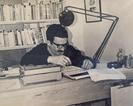Sharing "Gabo" with the World: Building the Gabriel Garcia Marquez Online Archive from His Papers at the Harry Ransom Center
Funded

Material Description
Following the death of the Nobel Prize-winning novelist and journalist Gabriel Garcia Marquez on April 17, 2014, the Ransom Center purchased his papers from his family. The remarkable Garcia Marquez archive, which arrived at the Center in December 2014, spans more than half a century and richly documents Garcia Marquez's singular life and work as a novelist, journalist, screenwriter, and social activist. The materials nominated for digitization include: -Extensive manuscript drafts with revisions for seven novels, ranging from the landmark One Hundred Years of Solitude (1967) to Memories of My Melancholy Whores (2004); a memoir, Living to Tell the Tale (2002); two non-fiction books, Clandestine in Chile (1986) and News of a Kidnapping (1996); one play; three screenplays; and shorter writings such as articles, introductions, poems, and speeches (including drafts of his Nobel Prize acceptance speech); -Notes in three notebooks for an unwritten book on the U.S. embargo of Cuba, circa 1975; -A selection of 100 photographs from forty-three albums vividly illustrating all aspects of his life over the course of nearly nine decades; -Twenty-two scrapbooks meticulously detailing his writings and life via news clippings from Latin America and around the world, including his early journalism written under the pseudonym Septimus, 1950-1952; -Nobel Prize ceremony memorabilia and nine passports recording his worldwide travel from 1957 forward. The papers support research about: Garcia Marquez himself, such as biographies, bibliographies, textual and literary studies, his critical reception, and literary translations; closely-related figures ranging from Mexican novelist Carlos Fuentes to Cuban leader Fidel Castro; subjects of Garcia Marquez's non-fiction, such as exiled Chilean filmmaker Miguel Littin and ten Colombian journalists kidnapped by drug lord Pablo Escobar in 1990; and more generally, the study of contemporary Latin American literature, history, and politics; filmmaking and screenwriting; journalism; human rights; and social activism.
Summary
The Harry Ransom Center proposes an eighteen-month project to digitize major segments of the papers of Gabriel Garcia Marquez (1927-2014), considered one of the most significant authors of the twentieth century and affectionately known as "Gabo" throughout Latin America. His family has given permission to share a huge trove of materials online, including manuscripts for novels, a memoir, screenplays, and non-fiction writings; notebooks; scrapbooks; photographs; and related ephemera. The Center plans to: digitize at least 24,000 pages and make them available as an online digital archive; enable FancyBox viewing of the images from within the finding aid; and implement Mirador Image Viewer to allow scholars to compare drafts of evolving literary works side-by-side. The project will allow unprecedented access to the creative mind of a major contemporary author--through papers never before made available to the public--to a worldwide audience for the benefit of scholars, educators, and students everywhere.
Program
Amount Requested
$126,730
Year Added
Institution
The Harry Ransom Center at The University of Texas at Austin
Contact(s)
- Dr. Stephen Enniss (Harry Ransom Center)
- Ms. Elizabeth Gushee
Date Range
1950 - 2013
Geographic Scope
A native of Colombia, Garcia Marquez frequently wrote novels set in fictional locations based on Colombia or other Latin America countries in which he lived and worked. He traveled internationally as a foreign correspondent and celebrity writer, with homes in Barcelona, Bogota, Cartagena, Mexico City, and Paris in later years.